You started with an intro to Base – Fossil, sleeved up some decks, played some games, and even found your way into the ‘99 Discord server, now what? (Link here: Intro to Base-Fossil Battle Box – Pokémon 1999 )
Well, that really depends which direction you want to go! Though, no matter which direction you choose, I’ll always recommend playing the format(s) you enjoy on TCGOne! (Link Here: Home – TCG ONE )
In my last article I showed everyone the 9 decks I chose for my personal Base – Fossil Battle Box (or Gauntlet) and even a 10th deck as an Honorable Mention. This time around, I’m showing you 10 more decks! Some of the decklists will be alterations to decks you’ve already seen, some will be aimed at more casual play and some will be aimed at more competitive play.
Base – Fossil is known for being a skill expressive format, so what types of decks can you play once you “Git Gud”? Let’s find out!
Once you’ve learned all the nuances and tight lines of the format, you can start playing decks that offer a wider variety of decision trees and even decks that aren’t necessarily that great, but can still win games when piloted effectively. The short version is that you’re allowed to play the decks that are more punishing and less forgiving than the “starter friendly” lists in the original article. Casual players will enjoy playing the off-meta rogue decks that offer a more diverse gameplay experience than the average metagame provides, while competitive players will enjoy the refined and dialed-in decks aimed at tackling the metagame head on!
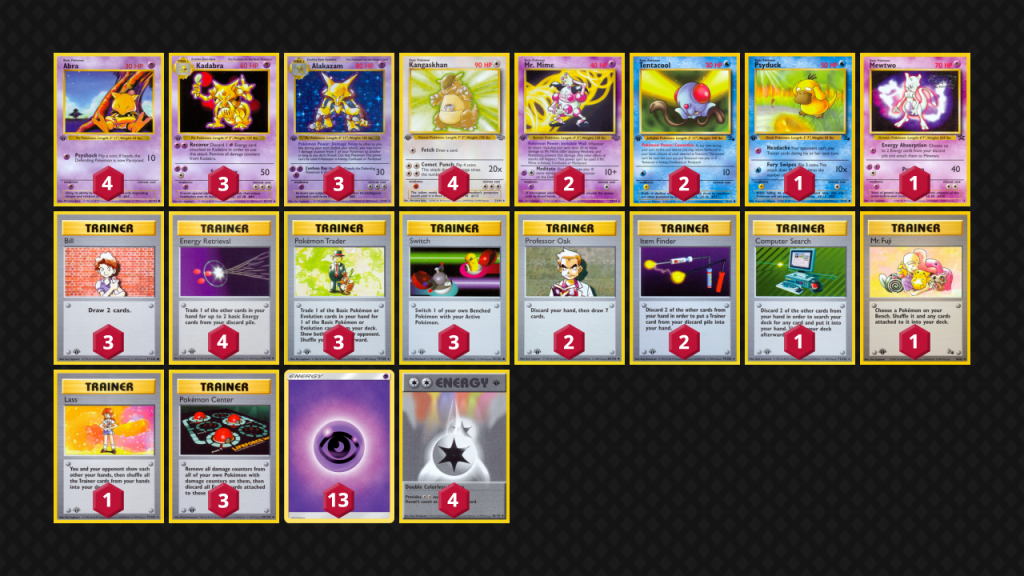
Let’s start with A, for Alakazam! This is a deck that readers will remember being mentioned in the “not quite good enough” category of the original article, and while its drawbacks still exist, it’s an extremely fun deck to play and creates interesting games in more casual environments. Not everyone is interested in playing all the best decks all the time, a majority of retro format enjoyers just want to sleeve up cool and interesting decks to enjoy with friends.
Alakazam is a Tank & Heal deck at heart, with Mr.Mime or Kangaskhan in the active, Alakazam can move the damage to the bench to be cleaned up with a Pokémon Center! The Pokémon in this deck have low damage output, high energy requirements and high retreat costs; your goal is to leverage those downsides effectively and aim for all 6 prize cards.
Kangaskhan and Trainer cards help you set up your board in the early game but once you’re set up, you want to start swinging! Another downside to this deck is that it’s easy to deck-out before you’ve taken all 6 prize cards, so playing conservatively and managing your resources will be the key to victory!
While attacking with Alakazam isn’t the primary gameplan, chaining together Confuse Ray attacks can be an effective way to take over the game. Additionally, using Psyduck and/or Lass to protect your Energy attachments will allow you to power up a Kangaskhan to start attacking into Psychic-resistant Pokémon (the x1 copy of Gust of Wind also helps work around those same Pokémon).
Though your main game plan is to stick Mr.Mime in the active all game and use Alakazam to make sure it never goes down. Who knew that 2 Psychic Pokémon with good abilities would be great when used together?
This decklist was finalized on 11/5/2025;
Tentacool’s ability allows you to return it to your hand every turn. Using Alakazam, you can move 20 damage over to the Tentacool, then put it back in your hand with the Cowardice ability. It’s like a free Potion every turn! While Mewtwo + Mr.Fuji help circumvent the deck-out problem.
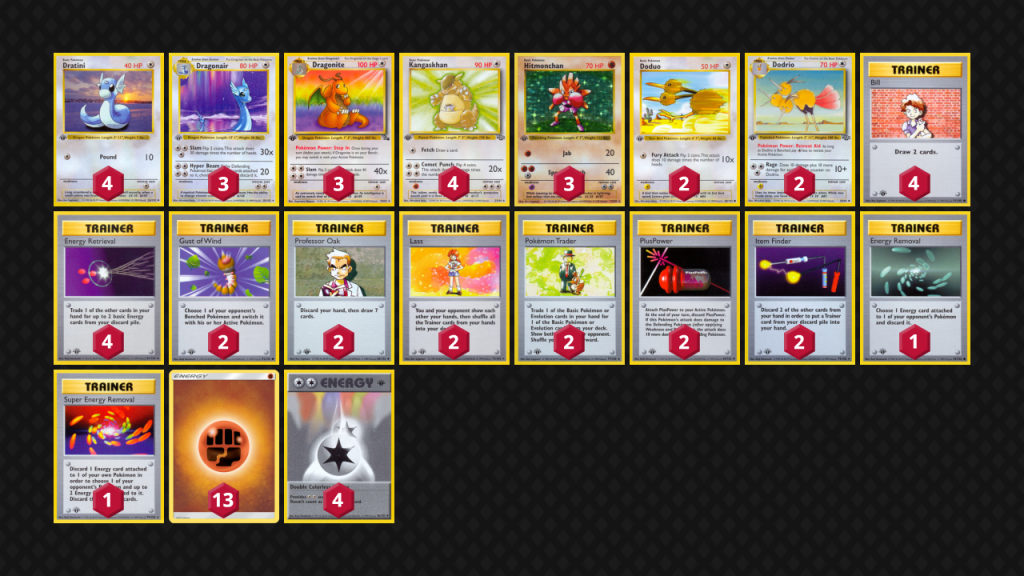
I didn’t intend for this article to be in alphabetical order, but we’re already here so let’s move on to B, for Big Stepper (or Dragonite)! This is something I would call a “casually-competitive” deck, since the deck was originally designed to fight and beat the boogeyman of the format, PsyStall. Though its slow pace and low consistency cause it to struggle with the rest of the metagame. Turbo decks like Blastoise can run you off the board while you’re still trying to set up and your only answers to fighting resistant Pokémon (such as Articuno) all require 4 energy and some coin flips. Competitively this deck isn’t a good place to be, however in more casual environments, the deck actually thrives.
Using Step-In + Retreat Aid always feels good and the ability to pivot so effectively makes for fun and interesting games where status conditions, energy removals, and even damage can all be played around with relative ease.
Lass gives you a way to fight back against Energy Removal heavy decks, giving you more chances to high roll with Dragonite and Kangaskhan’s attacks. More competitive players might not enjoy the variance of coin-flip based attacks, however more casual playgroups find that they make the game more interesting and exciting. This decklist was finalized on 10/25/2025
(If you’ve read Ashton’s article and want to try out some of his theory-crafting, don’t be afraid to drop a Bill for a Computer Search and run it back! Link Here: Bye-Bye, Bill: It’s Time to Dump “Draw 2” – Pokémon 1999 )
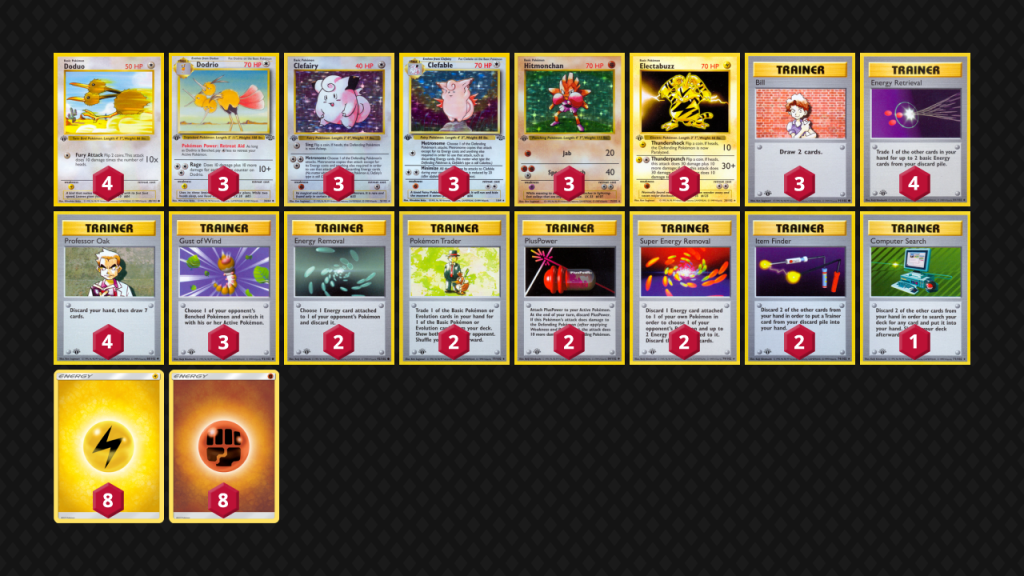
Is it considered cheating to put FableMaker in the “C” slot for Clefable? Maybe we’ll just abandon the prospect of alphabetical order… FableMaker’s deck building philosophy is somewhere between Haymaker and Wigglytuff decks, while also being a “DF” deck by accident.
All of your attackers can attack for one energy, making you resilient to Energy Removal heavy decks. While a Dodrio package and a high Gust count allow you to keep the match-ups in the active spot as favorable as possible. FableMaker’s greatest strength is also its greatest weakness, that is, FableMaker struggles with something that we call “Ceiling to Floor Disparity”. The ceiling of the deck (when it’s performing at its highest possible capacity) is a stark difference from when the deck is at its floor (performing at its lowest possible capacity).
While the deck was originally designed and touted as competitive during the ‘99 era, the ceiling/floor disparity has caused the deck to fall out of favor with the hyper-competitive community. So long as the opponent has high damage attackers that don’t resist Fighting, you’re in a good place. Anything else is, well… not great, since the deck lacks reliably high damage output once Hitmonchan is neutralized and/or Clefable has nothing good to copy.
Clefable is usually your source of high damage, copying powerful attacks for a single energy. Things like Kangaskhan, Dragonite, Venusaur, Arcanine, and Mewtwo, all hate to see a Clefable across the table! Hitmonchan will be your primary attacker in the early game while both players are getting set up, and Electabuzz makes sure you don’t get wall-stalled by something like Dodrio.
Pushing aside the hyper-competitive negatives, the deck is beloved by the casual community for its flexibility and adaptability. While the deck does have some downsides, its pedigree shouldn’t be ignored. FableMaker carries the design philosophies of multiple top archetypes, making it one of my preferred deck choices of the format in casual or semi-competitive environments.
(Credit to OldRod for inspiring the deck’s design! Link to OldRod’s YouTube channel here: Old Rod – YouTube )
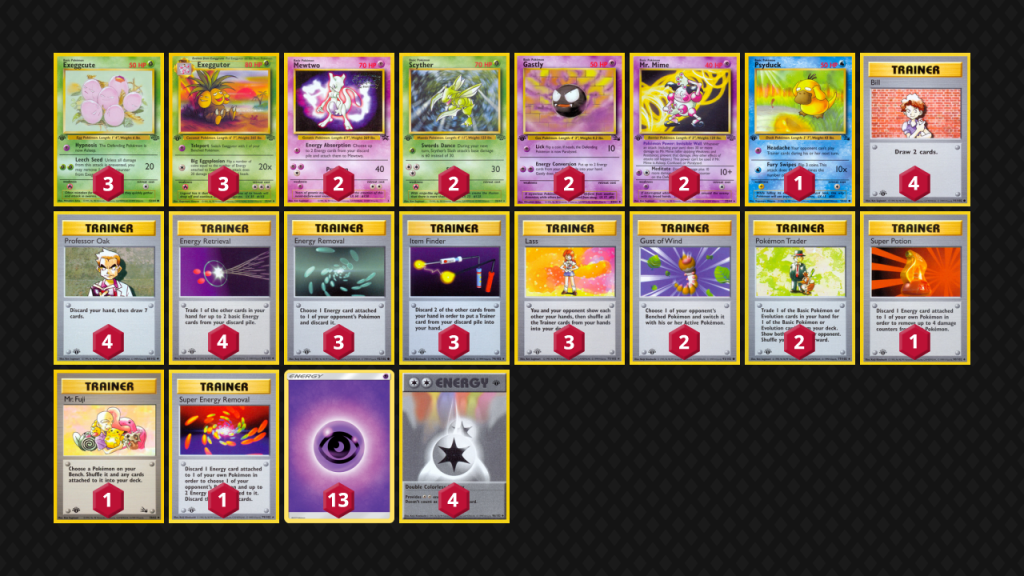
“E” is for Exeggutor (or Eggs)! Readers may remember from the 1st article, that I mentioned Exeggutor being one of my favorite archetypes and leaving it out of the gauntlet was a saddening experience for me. That’s okay though, because now I get to show you not just one, but TWO different Exeggutor deck lists!
The first one is the “default” Exeggutor deck, designed (to my knowledge) by Jason Klaczynski and then edited by the community afterwards. Specifically, Steve Caliente spent a lot of time with the archetype.
Exeggutor is a combo deck that can play midrange if it has too, but the primary gameplan is just to load Exeggutor up with a bunch of energy, throw a bunch of dice on the table, and ask your opponent “is that enough?”. I cannot stress enough how incredibly fun and satisfying this deck is when it “does the thing” and how rewarding it feels when you play the deck well on “midrange mode”.
The deck has managed to gain traction in both the casual and the semi-competitive communities, a testament to the deck being both enjoyable and serviceable!
(“Midrange Mode” refers to playing the deck on plan B, that is, using Gastly & Mewtwo to recover energy cards, or using Mr.Mime’s Invisible Wall to buy time. You can also use Psyduck’s Headache attack to lock opponents out of their own Mr.Fuji and/or Gambler after using your own Mr.Fuji to shuffle an energy-full Pokémon back into the deck, though more often you’ll use the Headache attack to keep (Super) Energy Removals at bay while slowly building up Energy on your Exeggutor.) This decklist was finalized on 11/5/2025
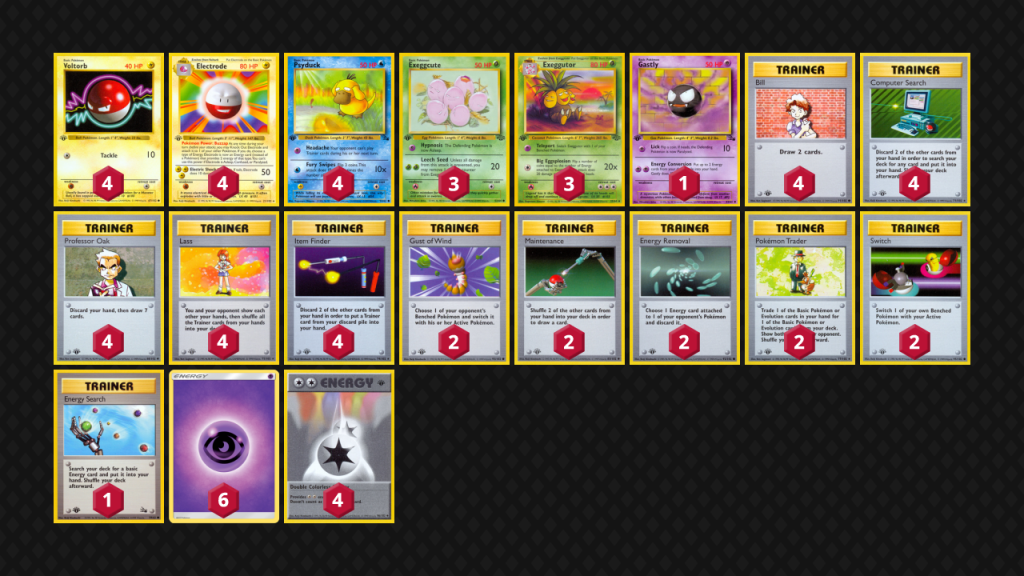
There must be a storm coming in, because we are stocking up on the eggs! This is Turbo Eggs, an archetype designed with the combination of Exeggutor and Arcanine/Electrode (9Bomb) deck building theories.
Normally I’m not an advocate for Turbo decks, but this one is worth making an exception for. ArcTrode decks are usually fun once or twice, but fall off really hard after that, thankfully this deck is vastly better than ArcTrode.
Your primary gameplan is still the same, rummage and loot through your deck turn one, setting up an Exeggcute and a couple of Voltorbs before ending the turn with Psyduck’s Headache attack. Then you want to evolve into Exeggutor and a couple of Electrodes, use the Electrode’s abilities to power up Exeggutor in one turn, play Lass to clear any Energy Removal cards from your opponent’s hand and then start swinging!
So, what makes this deck better than Arcanine? A few things, first of all, Exeggcute can inflict a status condition with one energy, something that Growlithe can’t do. Second of all, Exeggutor can “Teleport” back to the bench if it’s being faced with Energy Removals, something that Arcanine can’t do. Lastly, since Exeggutor doesn’t have recoil damage like Arcanine does, you don’t need to play any Defenders. Which not only frees up valuable deck space but also means you need to find one less piece when going for “the combo”, making this deck more consistent than its fiery counterpart.
A cool tech choice I stumbled upon while theory crafting with Ogrehvnds is playing one Energy Search to discard with Oak/Comp Search, so that Item Finder is an out to Energy cards! This decklist was finalized on 11/5/2025
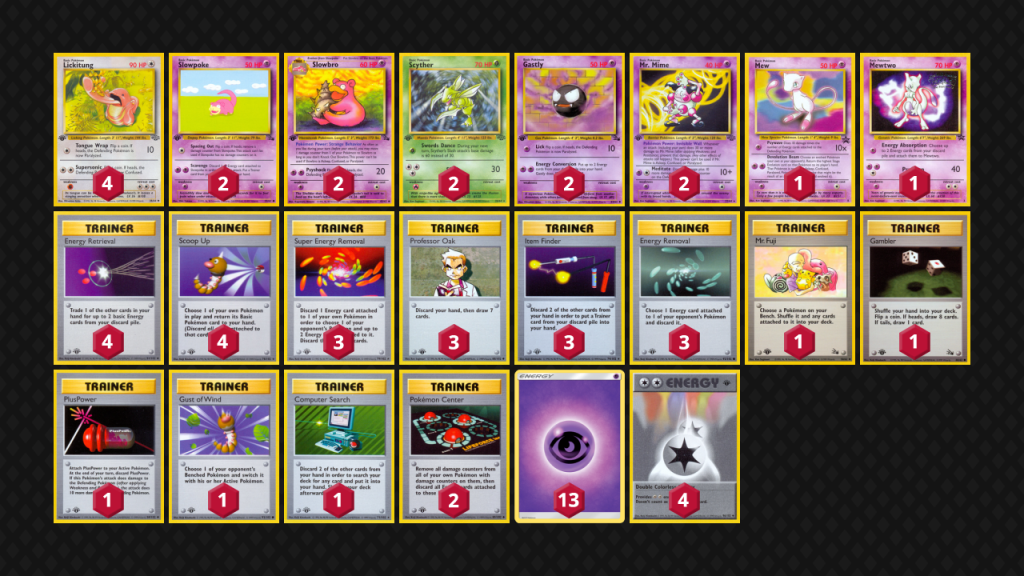
The last casual deck to cross the finish line is Slowbro. What an ironic coincidence. If you’re looking at this and thinking to yourself “Liger, isn’t this just different PsyStall?” you would be correct. I started with the Slowbro list on PTCGArchive and play tested different things before finally settling on this.
Overall, it’s just worse PsyStall, but that’s not a bad thing. Slowbro is a more fun and interesting version of stall, actively choosing to use an archetypal engine and not just a pile of good cards. Slowbro is a stall variant that’s fairer to play in casual and semi-competitive environments while still maintaining the feel and strategy of its original version.
While it is worse than pure PsyStall, I’d say it’s probably better than Alakazam and more on par with Venusaur. Stall games are usually much more interesting and dynamic than common opinions would lead you to believe, so I think it’s important to make sure at least one stall variant finds its way into the casual world. The deck does have a plus side though, by replacing Chansey (and reducing Scyther), we no longer need to play Double Colorless Energy.
The main game plan here is to use Slowbro’s ability to move damage off your active Pokémon and onto itself, before using Pokémon Center to heal the damage away, much like a Tank & Heal deck. This decklist was finalized on 11/5/2025
(Link to PTCGArchive Here: Base – Fossil – Pokemon TCG Archive )
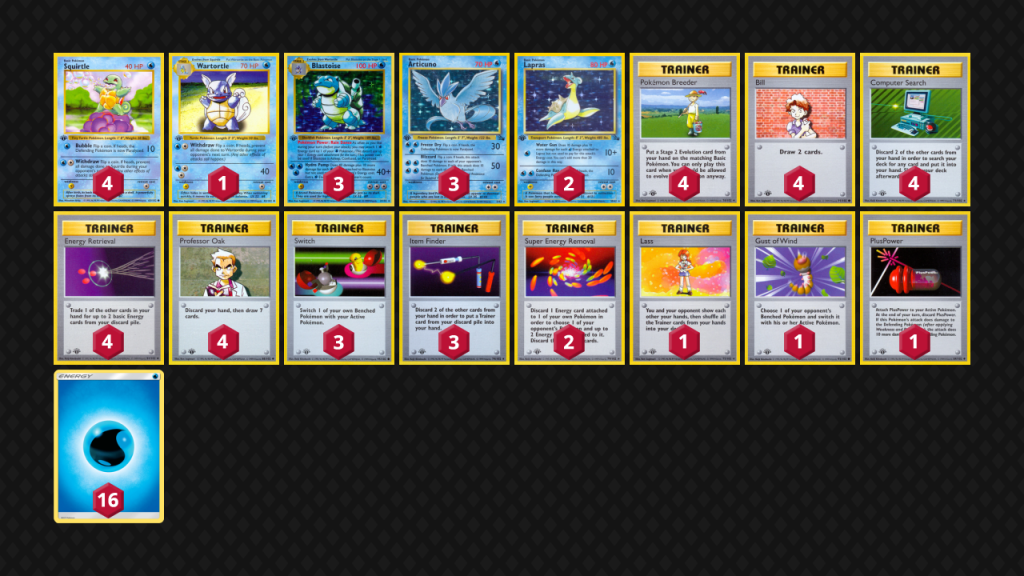
Alright, we’ve covered the “From casual” part of the title, let’s start getting into that “To Competitive” part of the title! Here’s the revisions for Rain Dance (or Blastoise). Big Man Blastoise is back, and he’s thrown off the training wheels!
You’ll notice that this version isn’t playing the two copies of Maintenance that the previous version had. It’s expected that once you’ve learned the match ups, sequencing, and resource management, that you “shouldn’t need” the Maintenance anymore. This version of the deck plays 2nd Lapras and 16th Energy instead, both of which are very important if you intend to take on PsyStall variants and still come out on top. (Credit to Ophthalmascope from the Discord Server for the decklist inspiration!) Lapras is our Invisible Wall Breaker, while 16 Energy (paired with 3 Switch) gives us the critical mass necessary to force through opposing (Super) Energy Removals.
Rain Dance will always be my favorite archetype in all of Pokémon, and our friend Ogrehvnds has won leagues with this deck before, so to say that I’m a believer in Blastoise is an understatement. The deck still suffers from a little bit of ceiling/floor disparity, but sometimes Lass into manual attachments, into Freeze Dry, will still get you there!
(Remember that Lapras’s Confuse Ray + Super Energy Removal is also another way to buy time when building up towards the combo!)
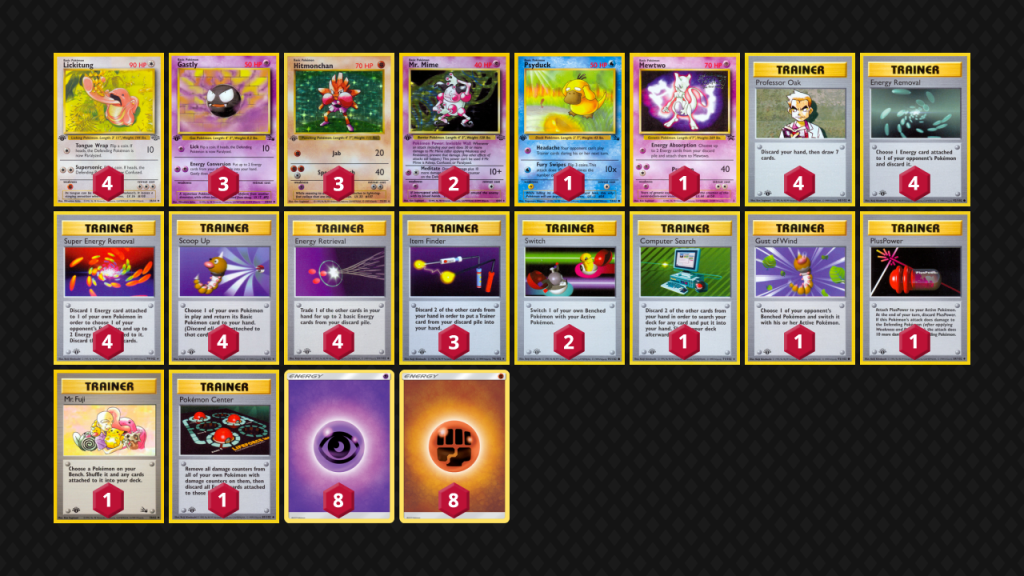
This is “LFP” (or Lickitung + Fighting + Psychic), a deck designed and developed by Ophthalmascope from the ‘99 Discord Server. Oph has been working on this for a while now and has recruited Jason Klaczynski and Ogrehvnds to ensure the deck has been rigorously play tested into good decks with good pilots. 25 years later and players are still finding ways to innovate the format; it’s truly an outstanding thing to see. My understanding is the primary premise is that this is the Base – Fossil equivalency to Ross Cawthorn’s “The Truth” deck, combining some of the best cards in the format in a new way. You also don’t have to play Double Colorless Energy, which I’m a big fan of. I’ve often found that DCE decks feel like playing “3-Color” and have both consistency and resiliency issues. -LigerStormShadow93
~
LFP eschews your DCE attackers in favor of giving you more play against Lickitung and Wigglytuff by using Hitmonchan. There is too much tension between Fighting and Psychic energy-using Pokémon to also include these attackers, and we also need to trim space for some additional Trainers. Hitmonchan is useful, but it is walled by many meta-relevant Pokémon. The additional switches are a must, as it vies with Lickitung to utilize the Scoop Ups. Gastly here serves as our obligatory “free retreater” and is also a viable attacker to counterplay rival Hitmonchans and other Psychic Pokémon that give us issues. Is it going to take the stall crown? Likely not, but it is a viable stall option and will likely place near the lower-top of the meta, as it still contains some of the game’s strongest cards. All credit to Oph for the original shell. -Ogrehvnds
~
Credit to Ogrehvnds for the second half of the write-up. (Link to Ogre’s YouTube channel here: ogrehvnds – YouTube )
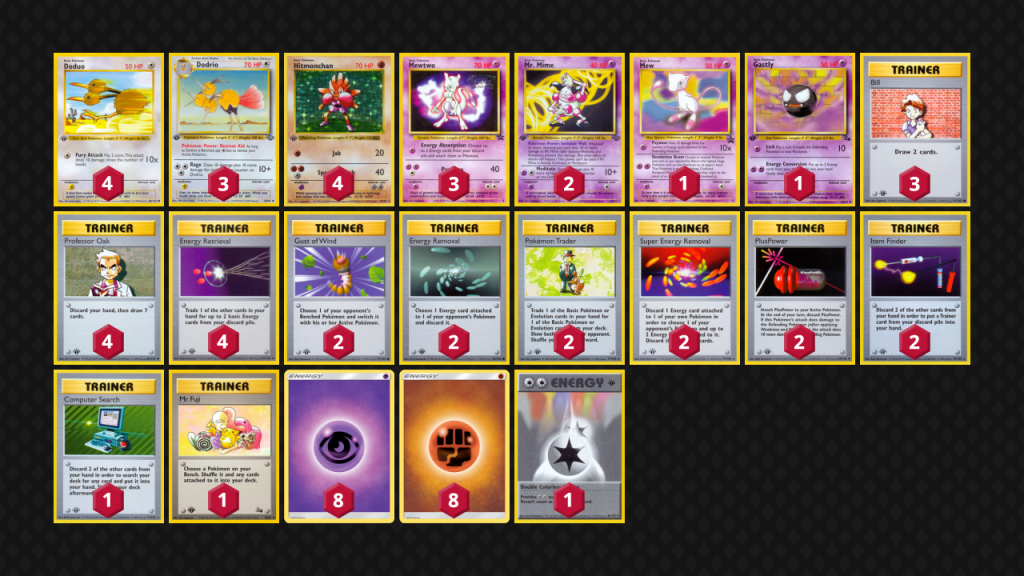
We’re already on the topic of Fighting and Psychic, so let’s look at the revised version of DFP (or Dodrio + Fighting + Psychic) When coming out of the gauntlet and going into the metagame, this archetype adapts the Promo Mew as a means to fight off opposing Mewtwo that would otherwise be a problem for the deck.
You’ll also see that we’re trimming back on Bill and adding some Computer Searches. This is a theory I had already been playtesting with (since Comp Search allows for turbo starts with Mewtwo) but was finally cemented on the decision after hearing Ashton and other community members discuss their success while also playtesting with the idea. Computer Search was still omitted from the original Battle Box version of the deck, since giving new players access to resource intensive cards with multiple decision trees usually doesn’t end well.
This particular archetype (list) is geared towards having a 55/45 into PsyStall, making it a strong tournament choice if you’re expecting a lot of PsyStall.
This decklist was finalized on 11/5/2025
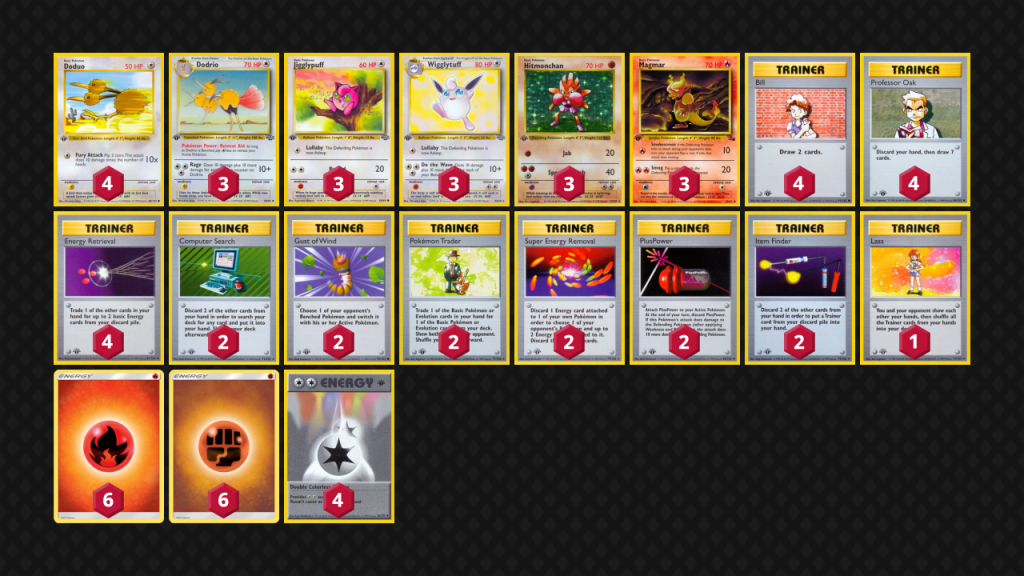
Last but certainly not least, is ”WigZoo”, a naming convention based on the “Zoo” archetype in Magic The Gathering. This version of the Wigglytuff archetype is the middle ground between DFW & Wigmar, choosing to play both secondary attackers instead of just one or the other.
While DFW aims to be primarily aggro, and WigMar aims to be primarily midrange, WigZoo ends up being an aggro deck that can play midrange. This flexibility and adaptability come at a cost though, playing two different energy types alongside Double Colorless Energy basically means that you’re playing a “3-Color” deck, so color fixing and resource management becomes more important than ever.
Baiy000r, WhiskeyWorship, and Edgar are all advocates for higher counts of Computer Search and Pokémon Trader, so this Wigglytuff deck list has more copies of both than the original Battle Box deck lists do.
WigZoo is the trusted choice of many top players and has multiple event wins to its name, proving itself as one of the top decks in the format. Shout out to Baiy000r, Whiskey, and Edgar for the deck list inspiration and countless conversations about the archetype! This decklist was finalized on 10/25/2025
Closing Thoughts; First of all, I want to throw out a HUGE Thank You to everyone who enjoyed my first article enough to make it the most viewed article on the site! That popularity allowed me the privilege of writing a second article for all of you, and I’m already starting to get ideas for a third article if this one does well too. Those of us who make content wouldn’t be able to if it wasn’t for all the love and support of the community, so Thank You! Please make sure to check out the links provided in this article (and the links provided in the first article) to find out more about this amazing format and see even more great content from other great content creators!

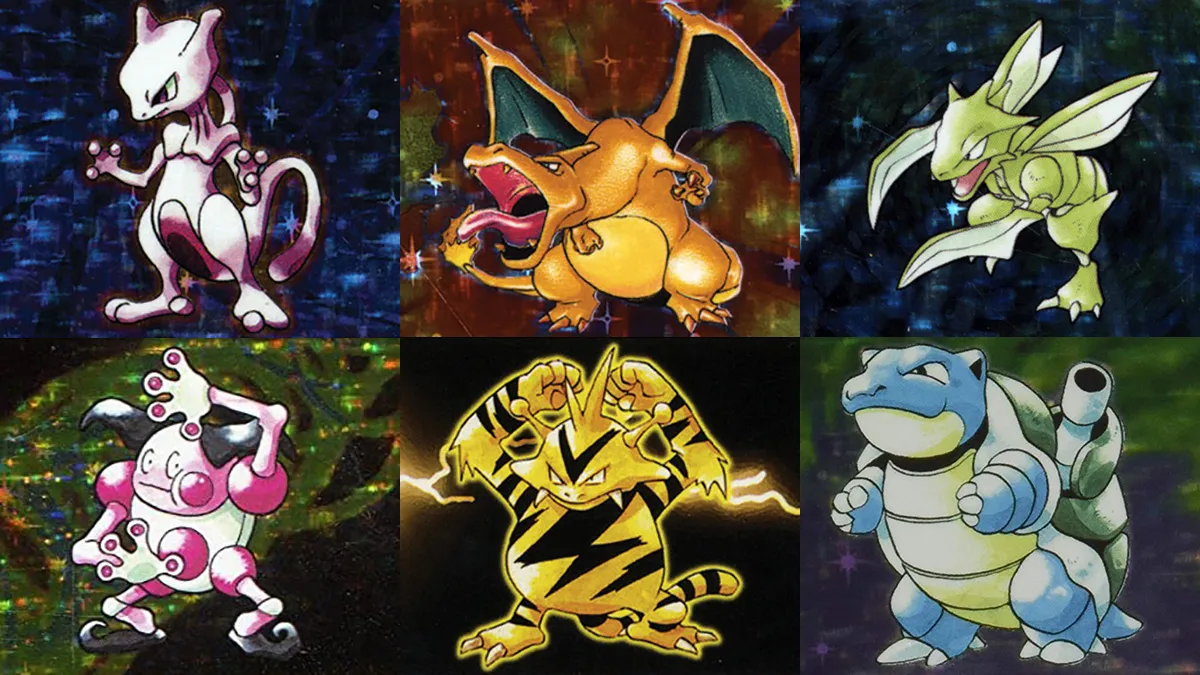
Leave a Reply